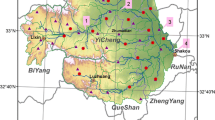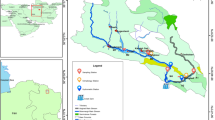Abstract
The impacts of climate change on water and nitrogen cycles in arid central Arizona (USA) were investigated by integrating the Second Generation Coupled Global Climate Model (CGCM2) and a widely used, physical process-based model, Soil and Water Assessment Tool (SWAT). With statistically downscaled daily climate data from the CGCM2 as model input, SWAT predicted increased potential evapotranspiration and decreased surface runoff, lateral flow, soil water, and groundwater recharge, which suggests serious consequences for the water cycle in this desert catchment in the future. Specifically, stream discharge is projected to decrease by 31 % in the 2020s, 47 % in the 2050s, and 56 % in the 2080s compared to the mean discharge for the base period (0.73 m3/s). A flow-duration analysis reveals that the projected reduction of stream discharge in the future is attributable to significant decreases in mid-range and low-flow conditions; however, flood peaks would show a slight increase in the future. The drier and hotter future also will decrease the rate of nitrogen mineralization in the catchment and ultimately, nitrate export from the stream. Since mean mineralization rate would decrease by 15 % in the 2020s, 28 % in the 2050s, and 35 % in the 2080s compared to the based period (9.3 g N ha−1 d−1), the combined impact of reduced catchment mineralization and reduced streamflow would predict declining nitrate export: from today’s mean value of 30 kg N/d, to 20, 15 and 12 kg N/d by the 2020s, 2050s, and 2080s, respectively.





Similar content being viewed by others
Explore related subjects
Discover the latest articles and news from researchers in related subjects, suggested using machine learning.References
Abbaspour KC, Yang J, Maximov I, Siber R, Bogner K, Mieleitner J, Zobrist J, Srinivasan R (2007) Modelling hydrology and water quality in the pre-alpine/alpine Thur watershed using SWAT. J Hydrol 333:423–430
Ahmad HMN, Sinclair A, Jamieson R, Madani A, Hebb D, Havard P, Yiridoe EK (2011) Modeling sediment and nitrogen export from a rural watershed in Eastern Canada using the soil and water assessment tool. J Environ Qual 40:1182–1194
Allen MR, Frame DJ (2008) Call off the quest. Science 318:582–583
Arnell NW (1999) Climate change and global water resources. Global Environ Chang 9 Supplement(1):S31–S49
Arnold JG, Srinisvan R, Muttiah RS, Williams JR (1998) Large area hydrologic modeling and assessment. Part I: model development. J Am Water Resour AS 34:73–89
Bae DH, Jung IW, Lettenmaier DP (2011) Hydrologic uncertainties in climate change from IPCC AR4 GCM simulations of the Chungju Basin, Korea. J Hydrol 401:90–105
Barnett TP, Pierce DW, Hidalgo HG, Bonfils C, Santer BD, Das T, Bala G, Wood AW, Nozawa T, Mirin AA, Cayan DR, Dettinger MD (2008) Human-induced changes in the hydrology of the Western United States. Science 319:1080–1083
Bieger K, Hormann G, Fohrer N (2012) Simulation of streamflow and sediment with the Soil and Water Assessment Tool in a data scarce catchment in the Three Gorges Region, China. J Environ Qual (Online first)
Buytaert W, Célleri R, Timbe L (2009) Predicting climate change impacts on water resources in the trophical Andes: effects of GCM uncertainty. Geophys Res Lett 36, L07406
Carbone MS, Still CJ, Ambrose AR, Dawson TE, Williams AP, Boot CM, Schaeffer SM, Schimel JP (2011) Seasonal and episodic moisture controls on plant and microbial contributions to soil respiration. Oecologia 167:265–278
Carpenter SR, Caraco NF, Correll DL, Howarth RW, Sharpley AN, Smith VH (1998) Nonpoint pollution of surface waters with phosphorus and nitrogen. Ecol Appl 8:559–568
Cayan DR, Das T, Pierce DW, Barnett TP, Tyree M, Gershunov A (2010) Future dryness in the southwest US and the hydrology of the early 21st century drought. PNAS 107:21271–21276
Conley DJ, Paerl HW, Howarth RW, Boesch DF, Seitzinger SP, Havens KE, Lancelot C, Likens GE (2009) Controlling eutrophication: nitrogen and phosphorus. Science 323:1014–1015
Domingo F, Serrano-Ortiz P, Were A, Villagarcía L, García M, Ramírez DA, Kowalski AS, Moro MJ, Rey A, Oyonarte C (2011) Carbon and water exchange in semiarid ecosystems in SE Spain. J Arid Environ 75:1271–1281
Duan Q, Sorooshian S, Gupta VK (1994) Optimal use of the SCE-UA global optimization method for calibrating watershed models. J Hydrol 158:265–284
Flato G, Boer GJ (2001) Warming asymmetry in climate change simulations. Geophys Res Lett 28:195–198
Flower HJ, Blenkinsop S, Tebaldi C (2007) Linking climate change modelling to impacts studies: recent advances in downscaling techniques for hydrological modelling. Int J Climatol 27:1547–1578
Forbes KA, Kienzel SW, Coburn CA, Byrne JM, Rasmussen J (2011) Simulating the hydrological response to predicted climate change on a watershed in southern Alberta, Canada. Clim Chang 105:555–576
Galloway JN, Townsend AR, Erisman JW, Bekunda M, Cai Z, Freney JR, Martinelli LA, Seitzinger SP, Sutton MA (2008) Transformation of the nitrogen cycle: recent trends, questions, and potential solutions. Science 320:889–892
Garfin G, Jardine A, Merideth R, Black M, LeRoy S (eds) (2013) Assessment of climate change in the Southwest United States: a report prepared for the national climate assessment. A report by the Southwest Climate Alliance. Island Press, Washington
Gassman PW, Reyes MR, Green CH, Arnold JG (2007) The soil and water assessment tool: historical development, applications, and furture research directions. T ASABE 50:1211–1250
Gober P, Kirkwood CW (2010) Vulnerability assessment of climate-induced water shortage in Phoenix. PNAS 107:21295–21299
Grimm NB, Fisher SG (1986) Nitrogen limitation in a Sonoran Desert stream. J N Am Bentholl Soc 5:2–15
Grimm NB, Fisher SG (1992) Responses of arid land streams to chaning climate. In: Firth P, Fisher SG (eds) Climate change and freshwater ecosystems. Springer, New York, pp 211–233
Holmes RM, Jones JB, Fisher SG, Grimm NB (1996) Denitrification in a nitrogen-limited stream ecosystem. Biogeochemistry 33:125–146
IPCC (2007) Climate change 2007: synthesis report. IPCC, Geneva
Jackson LE, Burger M, Cavagnaro TR (2008) Roots, nitrogen, transformations, and ecosystem services. Annu Rev Plant Biol 59:341–363
Karl TR, Melillo JM, Peterson TC, Hassol SJ (eds) (2009) Global climate change impacts in the United States. Cambridge University Press, New York
Larose M, Heathman GC, Norton LD, Engel B (2007) Hydrologic and atrazine simulation of the Cedar Creed watershed using the SWAT model. J Environ Qual 36:521–531
Li Z, Liu WZ, Zhang XC, Zheng FL (2011) Assessing the site-specific impacts of climate change on hydrology, soil erosion and crop yields in the Loess Plateau of China. Clim Chang 105:223–242
Litvak E, McCarthy HR, Pataki DE (2011) Water relations of coast redwood planted in the semi-arid climate of southern California. Plant Cell Environ 34:1384–1400
Liu DL, Zuo H (2012) Statistical downscaling of daily climate variables for climate change impact assessment over New South Wales, Australia. Clim Chang 115:629–666
MacDonald GM (2010) Water, climate change, and sustainability in the southwest. PNAS 107:21256–21262
Moriasi DN, Arnold JG, Van Liew MW, Bingner RL, Harmel RD, Veith TL (2007) Model evaluation guidelines for systematic quantification of accuracy in watershed simulations. T ASABE 50:885–900
Nash JE, Sutcliffe JV (1970) River flow forecasting through conceptual models part I—a discussion of principles. J Hydrol 10:282–290
Neitsch SL, Arnold JG, Kiniry JR, Williams JR (2005) Soil and Water Assessment Tool Theoretical Documentation. In: Texas A&M University, Texas Agricultural Experiment Station. http://www.brc.tamus.edu/swat/doc.html
Ryu JH, Lee JH, Jeong S, Park SK, Han K (2011) The impacts of climate change on local hydrology and low flow frequqncy in the Geum River Basin, Korea. Hydrol Process 25:3437–3447
Saleh A, Du B (2004) Evaluation of SWAT and HSPF within BASINS program for the Upper North Bosque River Watershed in central Texas. T ASABE 47:1039–1049
Schilling KE, Wolter CF (2009) Modeling nitrate-nitrogen load reduction stategies for the Des Moines River, Iowa using SWAT. Environ Manag 44:671–682
Seager R, Vecchi GA (2010) Greenhouse warming and the 21st century hydroclimate of southwestern North America. PNAS 107:21277–21282
Shaw MR, Harte J (2001) Response of nitroegn cycling to simulated climate change: differential responses along a subalpine ecotone. Global Change Biol 7:193–210
Tanzeeba S, Gan TY (2012) Potential impact of climate change on the water availability of South Saskatchewan River Basin. Clim Chang 112:355–386
USDA-SCS (1972) National engineering handbook section 4—hydrology
Welter JR (2004) Nitrogen transport and processing in the intermittent drainage network: linking terrestrial and aquatic ecosystems. Arizona State University, Tempe
White KL, Chaubey I (2005) Sensitivity analysis, calibration, and validations for a multisite and multivariable SWAT model. J Am Water Resour AS 41:1077–1089
Wilby RL, Dawson CW, Barrow EM (2002) SDSM—a decision support tool for assessment of regional climate change impacts. Environ Modell Softw 17:147–159
Williams JR, Jones CA, Dyke PT (1984) A modeling approach to determining the relationship between erosion and soil productivity. T ASABE 27:129–144
Winchell M, Srinivasan R, M.D. L, Arnold J (2008) ArcSWAT 2.0 Interface for SWAT2005: user's guide. In: Blackland Research Center, Texas Agricultural Experiment Station
Wu Y, Liu S (2012) Automating calibration, sensitivity and uncertainty analysis of complex models using the R package Flexible Modeling Environment (FME): SWAT as an example. Environ Modell Softw 31:99–109
Xu CY (1999) From GCMs to river flow: a review of downscaling methods and hydrologic modelling approaches. Prog Phys Geog 23:229–249
Zhou G, Wei X, Wu Y, Liu S, Huang Y, Yan J, Zhang D, Zhang Q, Liu J, Meng Z, Wang C, Chu G, Liu S, Tang X, Liu X (2011) Quantifying the hydrological responses to climate change in an intact forested small watershed in Southern China. Global Change Biol 17:3736–3746
Zhu WX, Hope D, Gries C, Grimm NB (2006) Soil characteristics and the accumulation of inorganic nitrogen in an arid urban ecosystem. Ecosystems 9:711–724
Acknowledgments
This study was supported by the Sycamore Creek LTREB (NSF grant number DEB-0918262) and the Central Arizona–Phoenix LTER (DEB-0423704 and BCS-1026865), and done in part while LY was a visiting scholar at Arizona State University. We appreciate constructive comments on the manuscript by two anonymous reviewers and Benjamin Ruddell.
Author information
Authors and Affiliations
Corresponding author
Electronic supplementary material
Below is the link to the electronic supplementary material.
ESM 1
(DOC 767 kb)
Rights and permissions
About this article
Cite this article
Ye, L., Grimm, N.B. Modelling potential impacts of climate change on water and nitrate export from a mid-sized, semiarid watershed in the US Southwest. Climatic Change 120, 419–431 (2013). https://doi.org/10.1007/s10584-013-0827-z
Received:
Accepted:
Published:
Issue Date:
DOI: https://doi.org/10.1007/s10584-013-0827-z




